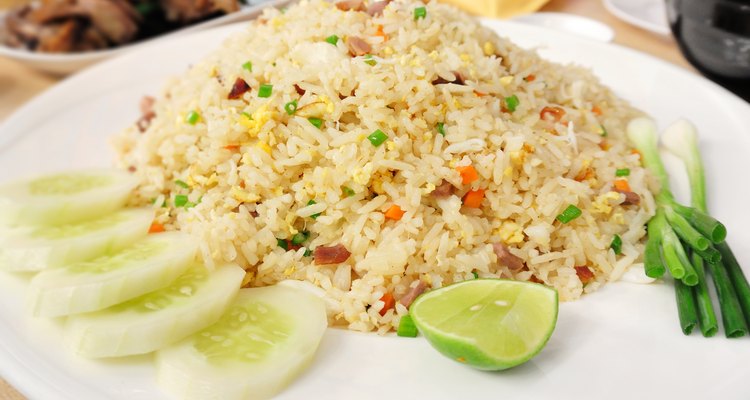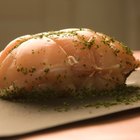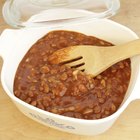
Thampapon/iStock/Getty Images
Pork fried rice, a popular dish in Chinese cuisine, generally combines scrambled eggs, stir-fried scallions, carrots, garlic, rice and pork with black bean sauce or soy sauce. Whether you make it yourself at home or pick up a pint from your local Chinese take-out shop, this dish combines the muscle benefits of protein with sustained energy provided by the carbohydrates in rice.
Calories and Fat
A 1-cup serving of pork fried rice contains 256 to 363 calories. Based on a 2,000-calorie diet, this comprises 12.8 to 18.1 percent of the calories you should consume in a day. Ideally, your calorie intake at each meal should range from 300 to 600 calories, so you may need to consume a smaller portion of fried rice if eaten as part of a larger meal, or eat a 1-cup serving of pork fried rice with a side salad or other dish to increase calories into the correct range. One cup of this rice also contains 5 to 14 g of fat, primarily due to the oil in which the ingredients are stir-fried as well as the eggs and pork.
Protein and Carbohydrates
The protein in your diet plays a critical role in building and repairing muscles. Your body does not have the capability to store protein, so eating protein-rich food is necessary. Additionally, protein helps maintain the function of your immune system; you need 46 to 56 g each day for optimal health. A 1-cup serving of pork fried rice provides 3 to 9 g of protein, depending on the ratio of pork-to-rice. When making this dish at home, consider including a higher amount of pork to get as much protein as possible. Pork fried rice serves as an excellent source of carbohydrates, macronutrients that supply energy for your body; each 1-cup portion contains up to 49 g -- 37.6 percent of the 130 g that the Institute of Medicine recommends we get daily.
Vitamins and Minerals
Including pork fried rice in your meal plan provides a boost of vitamin C; each 1-cup serving contains 19 to 25 percent of the daily recommended intake. Vitamin C helps maintain the strength of your bones and teeth and promotes wound healing. This dish serves as a rich source of iron as well, containing 11 to 14 percent of the amount you require each day.
Considerations
The pork in pork fried rice should be thoroughly cooked to avoid contracting any food-borne illnesses. Evidence published in the July 2010 issue of "Applied and Environmental Microbiology" notes that a strain of Salmonella found in pork is similar to bacteria found in chickens. This contaminant may result in stomach problems. It's also important to note that a 1-cup serving of pork fried rice contains 323 to 369 mg of sodium. Monitor your meal plan carefully to ensure you consume no more than 1,500 mg of sodium. Limiting your ingestion of sodium -- primarily by cutting back on salt and salty foods -- helps decrease your risk of high blood pressure. If you make pork fried rice at home, you may control sodium content by opting for low-sodium sauces.
Related Articles

How Long Does It Take for Pork to Spoil ...

How to Cook Pork Hamonado
Fried Clams Nutrition

How to Cook a Pork Neck Fillet

Should Pork Chops Be Washed Before ...

How to Braise Pork

The Nutritional Value of Norwegian ...

How to Prepare Breaded Pork Cutlets ...

How Do I Tell If Pork Has Turned Bad?

How to Cook Shredded Pork in a Pressure ...

How to Cook Marinated Pork Loin From a ...

How to Cook a Frozen Pork Fillet in the ...
Seafood Gumbo Calories

How to Cook Smoked Pork Knuckles

How to Make Pulled Pork In A Slow Cooker

Are Pork and Beans a Good Source of ...

How to Cook Pork in a Skillet
Can I Freeze Pork Immediately After ...

How to Tell If a Pork Roast is Done

How to Cook a Pork Breast Bone
References
Writer Bio
Nicki Wolf has been writing health and human interest articles since 1986. Her work has been published at various cooking and nutrition websites. Wolf has an extensive background in medical/nutrition writing and online content development in the nonprofit arena. She graduated with a Bachelor of Arts in English from Temple University.
Photo Credits
Thampapon/iStock/Getty Images